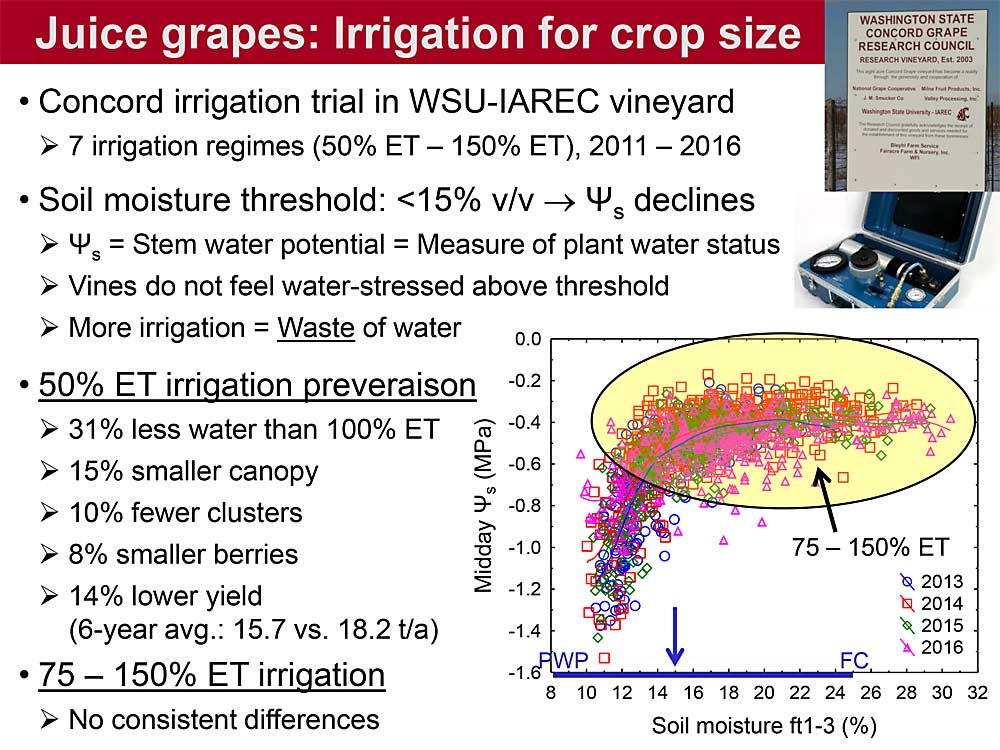There comes a point when more water does no good. The vines have made use of all they can and any extra does nothing for them.
“You’re essentially just wasting it,” Washington State University viticulture researcher Markus Keller told growers at the Washington State Grape Society meeting in Grandview, Washington, in November. That critical point where more water has no effect on juice grapes was one of Keller’s major points about irrigating wine and juice grapes.
In some ways, wine and juice grapes are the same. For both, temperature and canopy size drive water use. Also, both types of vines need most of their water between fruit set and veraison. After that, many characteristics about the crop have already been set, including berry size. No amount of irrigation can make up for berry size after the fruit turns color.
Back to that critical point where more is not more. Keller and his team made that conclusion after six years of irrigation trials at the WSU research vineyard, funded by the Washington State Concord Grape Research Council.
Reducing irrigation to 50 percent of evapotranspiration, or ET, before veraison resulted in a 15-percent smaller canopy, 10 percent fewer clusters, 8 percent smaller berries and a 14-percent drop in yield. However, varying irrigation levels between 75 percent and 150 percent of ET made no consistent differences in those same characteristics.
“This was quite illuminating for us,” Keller said. In light of his findings, he suspects some growers with overhead sprinklers and furrows may be wasting water.
Also, when Keller reduced water supply to 50 percent of ET after veraison, he saw no decrease in canopy size and yield. So, in a drought year, juice grape growers could save water with no yield penalty by applying 75 percent to 100 percent of ET before veraison followed by 50 percent of ET after veraison.

Irrigating juice grapes up to 75 percent of evapotranspiration before veraison will lead to larger berries and bigger yields, said Washington State University viticulturist Markus Keller. However, beyond that 75 percent threshold, more water does nothing for the vines, he determined through five years of trials. “You’re essentially just wasting it,” he said. (Courtesy Markus Keller/Washington State University)
Now, to wine grapes.
Generally speaking, less water before veraison will lead to smaller berries. Irrigation after veraison will affect berries, but it won’t make them any bigger, Keller said. In fact, after veraison, berry skin stiffens and will more likely split than expand with extra water, causing even more shriveling and dehydration.
However, some water after veraison will prevent those berries from shrinking. You can’t make them bigger through irrigation, but you can stop them from getting smaller.
But think beyond berry size, Keller suggested. Irrigation management gives you all sorts of control over your vines, and therefore your grapes, he said. Less water pre-veraison means a thinner canopy and fewer weeds, therefore less canopy and weed management costs and more overall control.
Meanwhile, use irrigation to control shade through your canopy. In Keller’s studies, clusters exposed to the sun had internal temperatures 27 degrees higher than ambient air temperature. Use regulated deficit irrigation — or RDI — to control those cluster temperatures, maintaining irrigation levels below ET for the season, Keller said.
How far below, which he calls the RDI window, depends on variety and production goals. Generally speaking, however, water red wine varieties preveraison between 25 percent and 50 percent of ET for smaller, sun-exposed berries with low to moderate yields. Give the lighter, fruitier wines a little more water.
Keller took Cabernet Sauvignon grapes down to 25 percent of ET before veraison with beneficial effects for quality but a reduction in yield, as long as he increased water supply after veraison to between 70 percent and 100 percent of ET. But, when he irrigated at 25 percent of ET from fruit set through to harvest, the vines declined and lost productivity.
For whites, irrigate pre-veraison between 50 percent and 75 percent of evapotranspiration.
“It’s all about optimizing your color, your tannin, your flavor and your aroma in the vineyard by managing water,” he said. •
—by Ross Courtney
Related: Lessons in doing the impossible






Leave A Comment